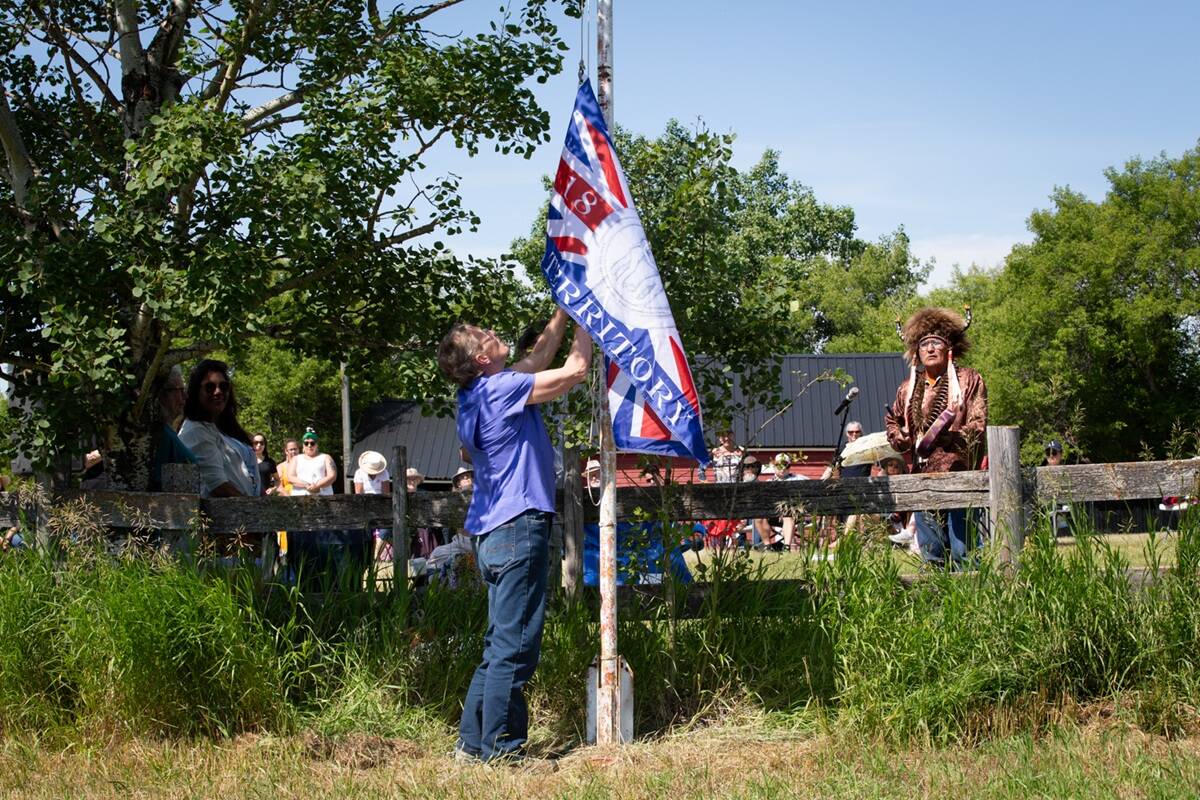The consolidated sell is proving its worth to members of Northwest Consolidated Beef Producers (NWCBP) despite rocky market conditions since the company was set up a couple of years ago. Fed cattle marketed through NWCBP last year garnered an average of $18.30 per steer and $18.43 per heifer above the CanFax weekly average.
NWCBP was officially established at Strathmore, Alta. by a handful of 13 feedlot operators in Sept., 2006. The corporation now includes 106 producer members and five supporting members from the three Prairie provinces. Together, they represent a standing capacity of close to 350,000 fed calves, another 100,000 backgrounders and 31,000 cow-calf pairs.
Read Also

Treaty Land Sharing Network expands reach in Saskatchewan and Alberta
The Treaty Land Sharing Network, which connects land holders with First Nations and Metis people, has expanded since it began in 2018
“With further packer consolidation, we need the commitment of our members to make this work. Some members are totally committed and stay the course. If we had another 50,000 to 70,000 cattle to market, we would be that much stronger,” says general manager Terry Schetzsle. “We’ve grown our membership, but haven’t added significantly to our cattle numbers this year.”
A rundown of the numbers showed fed cattle marketed by members through NWBCP increasing by more than 4,000 head in 2008 over 2007 to total 122,573. Introduction of the consolidated cull stock marketing service added another 4,000 head. Marketings from members in Saskatchewan and Manitoba have doubled.
Schetzsle’s comment speaks to the whole point of formalizing the consolidated sell as a company in the first place — to get more money for members through fair price discovery inherent in the cash market trade.
Contracting and grid programs offered by packers have put a dent in the number of finished cattle trading in the cash market. NWCBP believes feeders are at a disadvantage when dealing individually with the packing industry because they don’t receive fair price disclosure and a fair fed steer basis.
Putting large groups of cattle together catches the attention of packers, who have shown interest in negotiating the ask price and NWCBP is gaining a reputation for its uniform packages of fed cattle.
Keith Robertson, marketing representative, says the company is very pleased with the strength it has acquired in two short years. “We had projected higher marketings for 2008, but the feed advantage moved to the U. S. and a lot of members fed calves down there this year. The feed advantage has shifted back, so we’ll probably see an increase in 2009, though we have to remember that the Canadian industry as a whole is not feeding as many cattle as a few years ago.”
Part of it may be a matter of time for feeders to gain confidence in this new way of marketing. Feedback from members indicates that assigning marketing duties to NWCBP frees up time to concentrate on what they do best — feed cattle — particularly when labour is tight and they find themselves in a time crunch.
How it works
The company’s goal is to present the right kind of cattle at the right time to the right packers to optimize value for each type of cattle. NWCBP now has a team of four marketing representatives who work with members to estimate carcass characteristics for this purpose.
Members make the final decision regarding if and when they list and sell their cattle. The only condition is that they can’t offer other cattle for sale via other avenues during a week when they market through NWCBP. The feedlot retains ownership and risk until the cattle committed to the show list are sold.
The show list is generated each week for circulation to the packers by Monday at noon. Interested packers call NWCBP marketing manager, Vern Lonsberry, to negotiate the ask price, which the company sets each week for the classes of cattle on offer.
Industry wide, the largest percentage of product is moved as commodity beef, so NWCBP’s ask price is generally the same across the board unless a group of calves is significantly different from the rest on offer and would fit into a branded beef program. Sporadic discounts are another marketplace indicator that a dedicated marketing team has the capacity to monitor.
The marketing fee per head sold through NWCBP depends upon the membership level selected. It’s either
$5 or $6.50 for fed cattle and $10 for mature cattle. Marketing fees are the company’s main source of revenue because memberships are a one-time fee.
Marketing Activities
Generally, NWBCP’s weekly show list is large enough to set the pace for the Alberta cash market and most weeks, members have enough cattle on the show list to stop a backswing in prices. If not, and prospects look brighter for the following week, the show list can be rolled ahead. Members remain in complete control of the cattle, so they can choose to go with the roll or withdraw.
“We have to be very realistic in our ask price. We don’t just pull numbers out of the air and give it a shot in the dark,” Lonsberry explains. Tools such as historic basis levels, futures market, U. S. and Canadian cash markets, packer inventory and boxed beef movement are all taken into account when setting the weekly ask prices. NWCBP also has a working relationship with Consolidated Beef Producers in the U. S. to share information.
The basis is the root of the ask price and that’s been erratic to say the least — “one week the packers bid us at a $9 basis and the next week at $18,” Lonsberry explains. It’s only the odd situation in which other factors may be more influential than the basis. Price transparency is assured and members have access to up-to-the-minute marketing information and archived selling prices on the website.
Lonsberry says that uncertainties surrounding U. S. country-of-origin labelling widened the basis by at least $4 and sales to U. S. packers fell from 19 per cent to eight per cent on the year because U. S. packers went to taking Canadian cattle only one day a week.
At times, and depending upon market conditions, NWCBP has sold finished cattle from Western Canada to plants in Washington, Nebraska, Utah and Colorado.
In Canada, slow negotiations in the sale of Lakeside at Brooks to XL Beef created short-term uncertainties. With the sale finalized in March, everything was business as usual from NWCBP’s perspective.
Purchases by the former Lakeside packers remained steady at 58 per cent of NWBP sales last year, while XL’s purchases made up 10 per cent of the sales, down five per cent from the previous year. Cargill increased purchases from NWCBP from six per cent to 22 per cent.
Robertson says the Lakeside plant remains a strong contender for NWCBP cattle. The difference in previous purchasing patterns between it and XL Beef is that they had different specs to fit different end-use customers and he sees no reason to believe that has changed. The plan called for shifting the fed cattle kill to the Lakeside location, with Calgary and Moose Jaw looking after the culls. Now Moose Jaw has been closed until the fall.
New Initiatives
Due to the realities of the current marketplace and in response to members’ needs, NWCBP has been offering “consolidated contracting.” Though NWCBP is fundamentally opposed to contracting because it guarantees a captive supply, which is detrimental to the cash market, the company has to be able to shift as the industry dictates, Robertson explains. At the moment, some financial institutions require feeders to use contracting for risk management purposes. Consolidated contracting is a compromise, operating on the same concept as the consolidated sell by using the strength of numbers to get a better price — whether it be contract or cash.
A resolution asking for the company to look at the potential for consolidated buying and selling of feeder cattle was carried at the group’s annual meeting. Robertson says feeders have expressed lots of interest all along in this type of program. Now that the marketing program for finished cattle is up and running smoothly, NWCBP can start to consider add-on services.
The first add-on introduced in February is a feeder financing program for members offered through Stockmens Assistance Corporation of Saskatoon in partnership with Farm Credit Canada. Schetzsle says it’s a clear-cut and simple program available for purchases of all classes of feeder cattle including calves, yearlings and feeder cows as well as financing home-raised calves. It offers some advantages for producers over the cost of bank loans and inflexibility of loan guarantee programs.
Members voted against a resolution calling for NWCBP to support the newly-formed Alberta Beef Alliance on the grounds that many NWCBP members are members of other industry organizations that are already designated lobby groups and there is a growing number of members from outside of Alberta. There has been some interest from feeders in Ontario as well.
For more information contact the office at 403-901-1986 or visit















